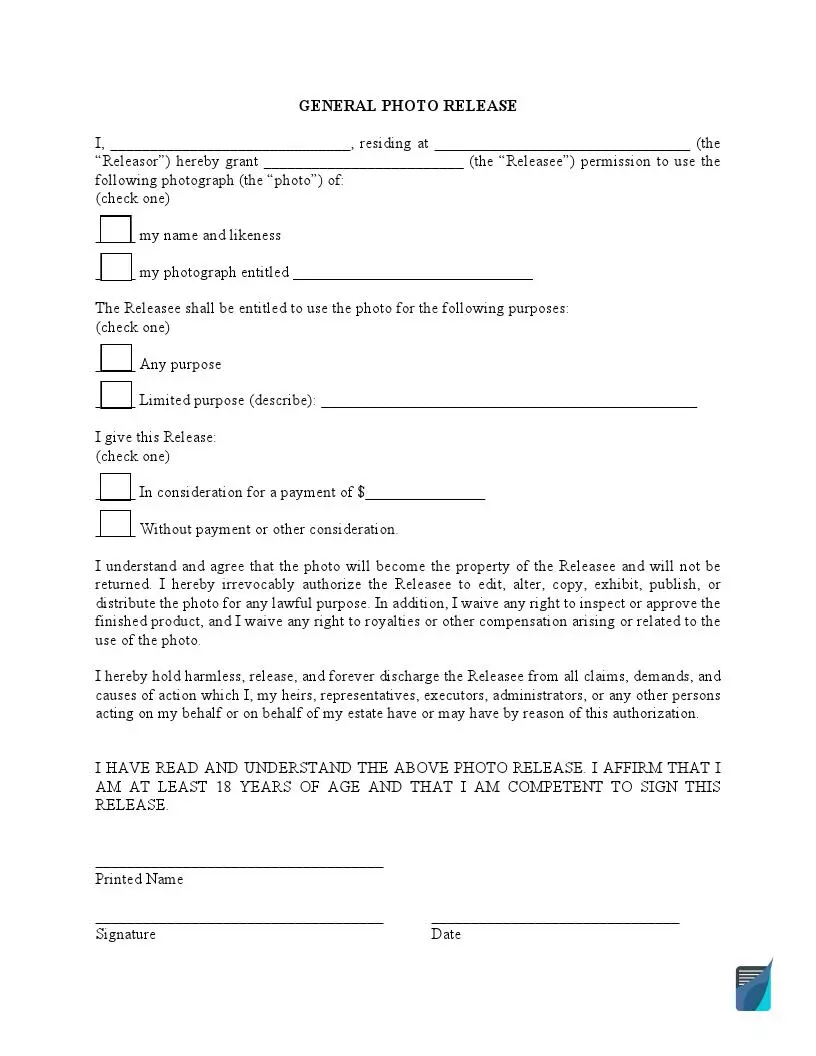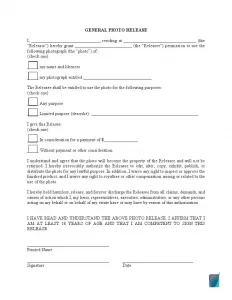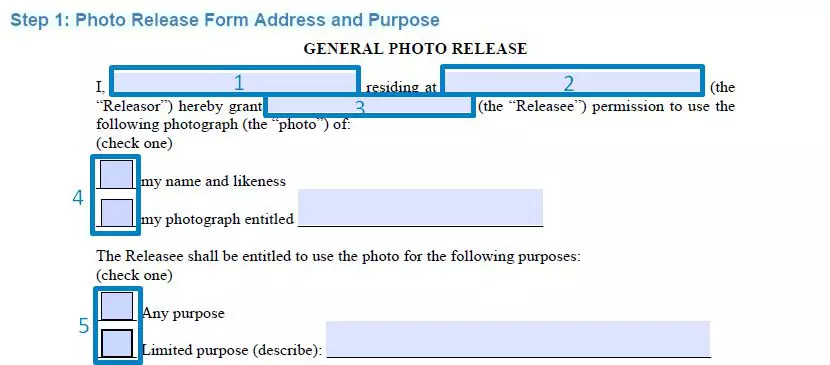Photo Release Form
A photo release form is a document that permits the usage of a photograph by a person/persons in it whether this is for personal or public use. This grants a person taking the photos the rights to them, and they might but are not obliged to use this right; they can choose to release them at his or her will. The rights to a photo can be released in different ways. The most common of them are for free, for a particular fee, or when royalties are involved. More specifically, when any sort of payment is involved, the rights to the image(s) are not granted the release of liability form has been properly crafted and validated and until payment has been received.

Build Your Document
Answer a few simple questions to make your document in minutes
Save and Print
Save progress and finish on any device, download and print anytime
Sign and Use
Your valid, lawyer-approved document is ready
Model release form – A document established between a person who will use the photography, a person who took it, and a person in the photo or person who owns the property captured in the photo. In other words, a model release form is the written permission of a person or property owner to publish the image featuring them or their property on the net or in print ads or use in any other way specified in the document.
Photography copyright release form – Written permission to use professional images to make copies of them or for any other commercial use. The release form commonly includes details about the creator of a photo or person in it and a person or entity who is authorized to use it, types of use, and the description of the image. The document also states that the releasing party gives up any claims they might have against the receiving party in relation to the use of the considered photos.
Photo release form for minors – A document that permits entities or individuals to use photographs that have the image of a child. Based on the fact that the actual releasor is under 18, the document needs the signature of their legal representative – a parent or guardian.
Employee photo release form – A document that authorizes a third party to take and keep photos of an employee for any commercial use, such as for the company’s website, advertisements, or job postings. To be valid, the form should be signed by the employee. It should explain that the photos with the employee in them can be used by the employer and any designated agents on an at-will basis. The form typically covers many different circumstances and does not have an expiration date.
Pet release form – A document that authorizes a person or entity to take and use a photo featuring a domestic animal. It is the owner who might have issues with having their animal in someone’s photos, which is why they should give the consent to feature an animal in the photographs. Such consent should have a written form.
Daycare photo release form – A document that enables taking photos of a child at daycare or during various activities. The parties are the child’s parent or a guardian providing the consent and a person taking photos. The document commonly authorizes the latter to use the photo(s) to promote daycare services using both print or digital versions of the photo(s).
A Photo Release Form: Specifics of Usage
A photography release form is a document that gives a photographer, entity, or any third party explicit permission to use the photographs with a certain person/property in them for personal or commercial use. The releasor (the person who releases the rights to the image) grants certain rights to the releasee (the person getting permissions) and can request:
- royalty (typically, a percentage of profits or recurring payment made to a photo owner)
- attribution or credit (the user uses the image for free, but has to mention the title of the image, the original creator, the source, and the type 0f license)
A photography release form is never needed when taking photos in public places, though. Examples of this can be seen anywhere from YouTube videos, television shows, or just about any public photograph you may have seen. Generally, on any public property, it is perfectly legal to take any photograph you want without having to obtain a signature on the photography release form from people in your photo.
Photo Release Form Details
| Document Name | Photo Release Form |
| Other Names | Photography Release, Image Release |
| Avg. Time to Fill Out | 7 minutes |
| # of Fillable Fields | 15 |
| Available Formats | Adobe PDF |
How to Make a Photo Release Form: 3 Steps
Photo release forms should be utilized by parties who want to get the right of photos that were taken of them or that they had requested to be taken. Normally, when a photographer takes a photo, they are granted the rights to the image by default and can protect their rights to it by putting watermarks on a photo. If somebody decides to buy such a photo, a photography release form grants the buyer the rights to the photo and the absence of any claims from the photographer. In such a case, the copyright watermarks would need to be removed.
There are commonly 3 steps you would need to take in order to get a photo release form and consequently, the right to certain photos.
Finding a good photo release template
There are many different release forms on the internet, some of which are very obscure. This is why it is important to first download the correct photo release form before using it for specific business purposes. A way to help narrow down any confusion would be to think about what/who is being photographed. The most popular by far is a model photo release form, which is when a photo intentionally captures a person or somebody’s property. However, there is no standardized form, which is why it is important to include the key elements:
- Name of the photographer or person(s) granting rights to the image
- Name of the model or property in the photo
- Address and contact details of the releasing party
- A detailed description of the image
- How long the form is valid for, that is for what period the rights to use the photo will be granted
- The purposes of releasing the rights to the image
- Any conditions of participation between the releasing and receiving parties
If you need a well-written template that will explicitly give the consent to use your photos under certain circumstances, make use of one of our templates presented on this webpage. Just choose the format, download the form, and start using it for your business purposes.
Communication Between the Parties Involved
It is vital to give clear instructions to the person(s) receiving the rights to the image to ensure mutual understanding of the purposes of its use. This includes any commercial use, distribution of photo(s), use in digital marketing, branding, print advertisements, handouts, etc. A detailed discussion of the payment (form, amount, and date) must be communicated as well. Furthermore, instructions should be given to the receiving party about the revocation of the photo release form if allowed, under what circumstances it may be done, any royalties associated with the use of this image. Another piece of information to include is who may receive the royalties if they are implied by the document, and finally, what parties are going to be required to sign the document.
Signing the Form
Photo release forms are very common, and most photographers have them ready to go before a photoshoot begins. These forms are so often used that a lawyer or notary is not needed during the signing process. It is important to remember that even though a notary is not required to be present during signing, this document is still binding.

How to Fill Out a Photo Release Form
Photo release forms are generally short documents that include only essential details about giving the rights to specific photos to third parties.
Step 1 – Name, address, and purpose
The document should start with the name of the releasor, that is, the person who gives permission to use the photo with them in it. Their mailing address, city, and state should be mentioned here.
Next, the purposes of usage of the specified photos should be mentioned in the document. These might be copyright purposes, illustration, advertising, web publishing, or print. Release form should also describe the type of media release of which is documented.

Step 2 – Payment
The next section is the Payment section. It should specify whether there will be a payment for release. If there is any, the amount should be specified. If the release implies paying royalties for the photographs, this fact should be included here as well.

Step 3 – Revocation
Include the revocation section. It should tell whether or not the revocation by the releasor is possible. If they want to be able to revoke the release at any moment notifying the releasee in writing, the document should explicitly tell that.
Step 4 – Signatures
The last step is putting the signatures of the parties along with their print names and dates.
When a photo release form is connected with someone who is not of legal age (this age will vary by state), at least one parent or legal guardian must be present in the document and sign the form. Each state defines the age of adulthood differently so it is important to look at your local laws or refer to legal counsel if necessary. At the same time, legal emancipation of a minor would mean that the signature of a parent/legal guardian is not needed.
If you need photo release forms, use our document builder. It lets you get a customized document in just several minutes. You can easily download and print release form.
